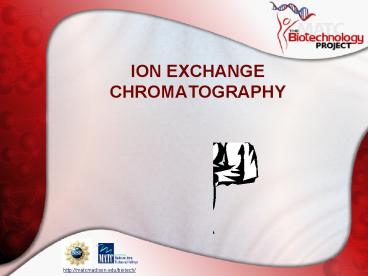ION EXCHANGE CHROMATOGRAPHY PowerPoint PPT Presentation
1 / 31
Title: ION EXCHANGE CHROMATOGRAPHY
1
ION EXCHANGECHROMATOGRAPHY
2
Type Of Column Chromatography
- Gel permeation
- Ion Exchange
- Affinity
- Hydrophobic Interaction
3
Basic Idea
- IEC is about interactions between positively and
negatively charged molecules - Ion exchange
4
Advantages To IEC
- High resolution
- High capacity
- Generally preparative
- Does not alter proteins
- Used for protein purification
5
Four Components To The Set-Up
- Matrix (bead, resin)
- Charged groups on resin
- Mobile Counter Ions
- Sample
6
I Matrix Is Support
- Matrix, polymeric, porous beads
- Sepharose , Sephacel, Sephadex
- Packed (poured) into the column as a slurry
7
II Charged Groups
- Charged groups- covalently bound to matrix
- DEAE is positively charged
- CM is negatively charged
- So, have, for example, DEAE Sephadex, type of ion
exchange resin
8
III Mobile CounterIons
- Ions that move in buffer solution
- Flow through the column and interact with charged
groups on the beads - Cl- for DEAE
- Na for CM
9
Terminology TwoTypes Of IEC Resin
- Anion Exchangers
- DEAE is positively charged
- Binds anions (-) so DEAE is an anion exchange
resin
10
- Cation Exchangers
- CM is negatively charged
- Binds cations () so CM is a cation exchange
resin
11
IV Sample
- Sample interacts with charged groups on the beads
- Consider sample in more detail as describe the
process of IEC
12
Six Stages To IEC
- Set up column other equipment (plumbing)
- Prepare resin pour column equilibrate resin
- Load sample onto column --adsorption
- Wash unbound off column
- Desorption elution
- End desorption regenerate column (optional)
13
Stage I Set Up Column
- Attach column to ringstand
- Attach pump (optional)
- Attach detector (optional)
- Attach strip chart recorder
- Attach fraction collector (optional)
14
Stage II Equilibration
- Prepare resin
- Pour into column
- Ion exchanger is brought to starting state
equilibrated - The charged groups on the beads are associated
with mobile ions from starting buffer - We use 0.2 M NTM buffer has 0.2 M NaCl
- Cl- ions are associated with all the DEAE
positive sites
15
Stage III Adsorption Of Sample
- Apply sample to the column --loading
- ß-galactosidase has a net negative charge and it
will stick -- adsorb - Some contaminants flow right through
- Other contaminants also stick to beads
16
Stage IV Wash Off Unbound
- Wash with 0.2 M NTM
- Unbound materials wash off
17
Stage V Elution
- Slowly increase salt concentration in buffer
mobile phase from 0.2 M to eventually 0.5 M - We will use a continuous gradient method
- The most weakly bound solutes fall off (elute)
first - Eventually the chloride ions displace
ß-galactosidase and it also elutes - As material comes off the column, collect it in
fractions - 0.5 mL in small tubes
18
(No Transcript)
19
Stage VI End And Regenerate
- Can elute rest of solutes with high ionic
strength buffer - Regenerate the column with original buffer, in
our case, 0.2 M NTM (optional)
20
What MakesProteins Adsorb And Desorb From The
Column?
- Proteins have charges because their amino acids
are charged - At a given pH, different proteins have different
charges, because they are composed of different
amino acids
21
Charge On Proteins
- Overall net charge on a protein is determined by
the R groups of its amino acids - Some amino acids have R group with positive
charge, others negative charge, others no charge
22
- In theory, IEC can separate proteins that differ
by only one charged group
23
Charge Distribution
- Charge distribution influences adsorption
- How charges are distributed on the folded protein
- Some amino acids may not be available to interact
with environment
24
pH Of Environment Is Crucial
- pH affects stability of proteins
- pH of environment affects charge on a protein
- pH is controlled with the buffer chosen
25
More About pHAnd Protein Charge
- pI - Isoelectric point
- Definition The pH at which a protein carries no
net charge
26
(No Transcript)
27
pI Is Important
- First, pI for a protein of interest determines
whether use cation or an anion resin
28
(No Transcript)
29
Isoelectric Point
pl
Use anion exchange
Net charge on protein
pH
2
4
6
8
Use cation exchange
30
pI
- Also, usually dont want to use a pH where the
protein has no charge at all because it will
never stick to the beads - So, for example, pI is 6.2, may want to use a
buffer at 7.2.
31
Capacity OfColumn
- Measure of ability to adsorb sample
- Based on charge or equivalents
- Depends on molecular weight of proteins because
greater MW usually means more charged groups - Approximation is often used
- 0.5-1 g protein for 10 mLs gel matrix

